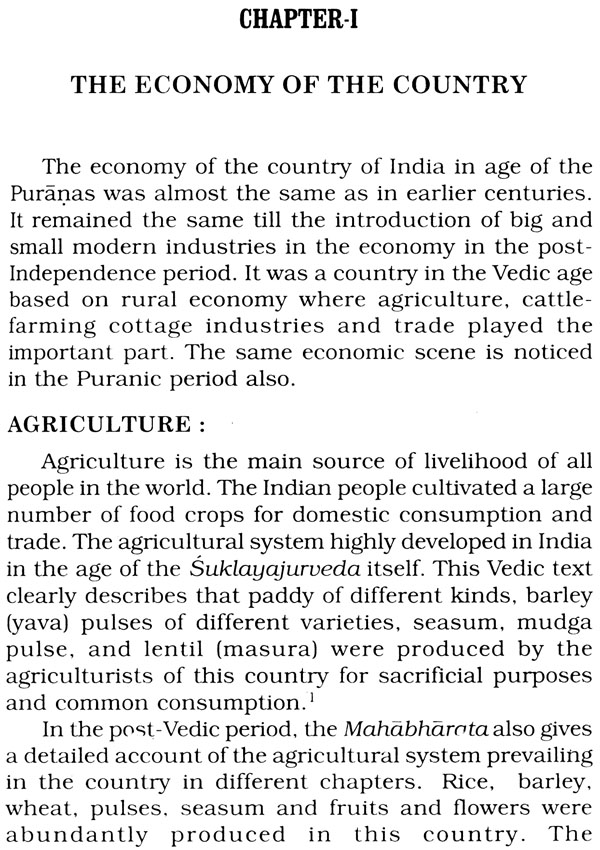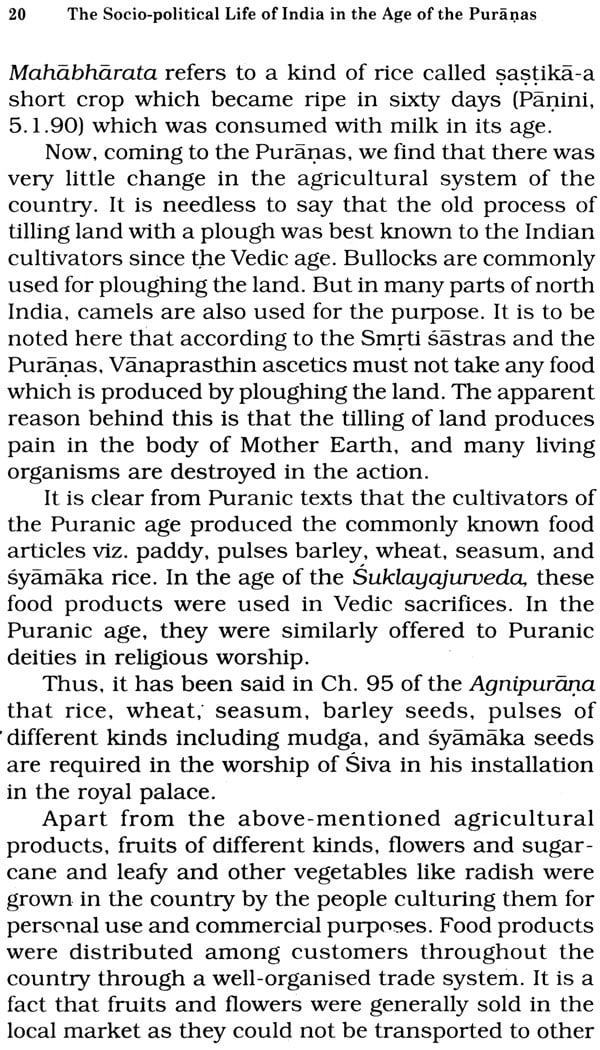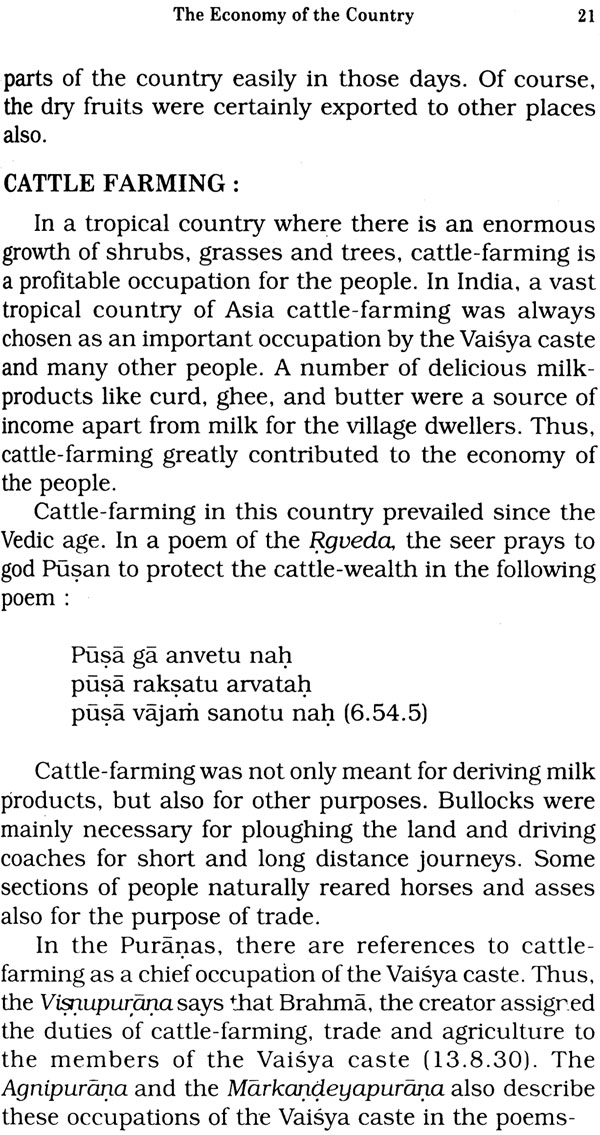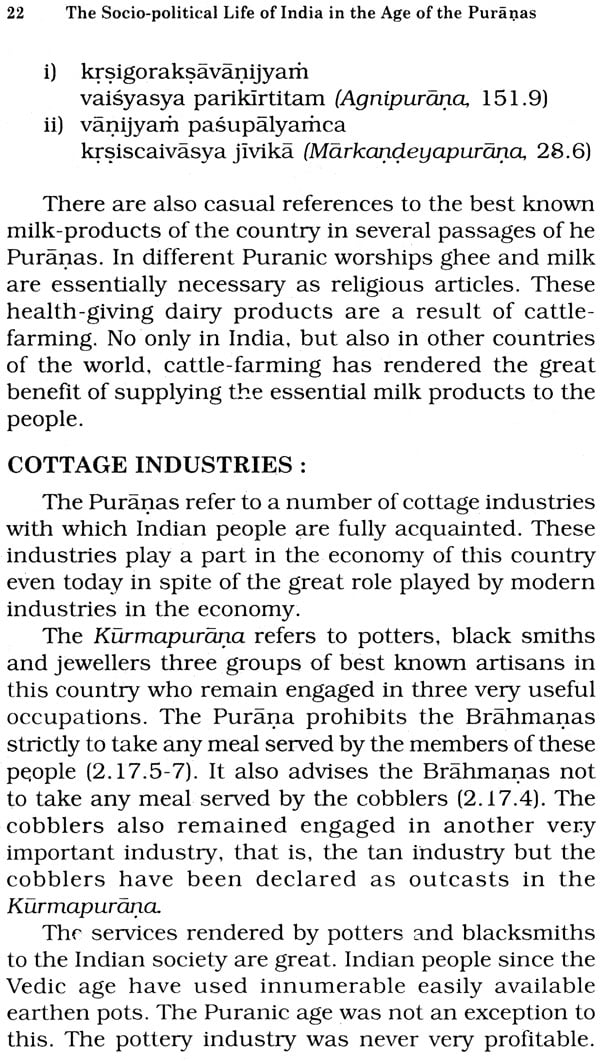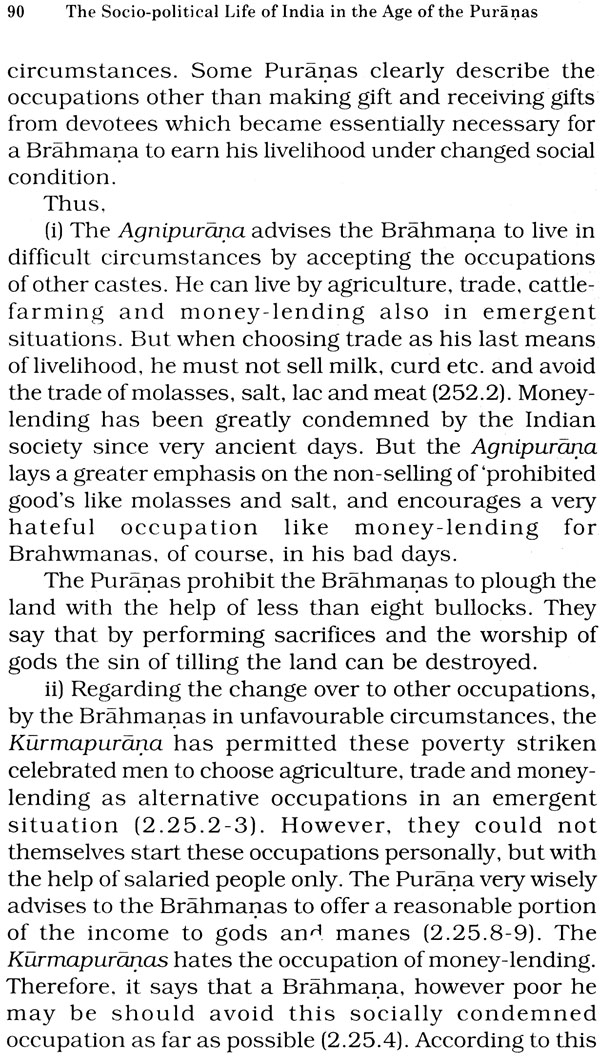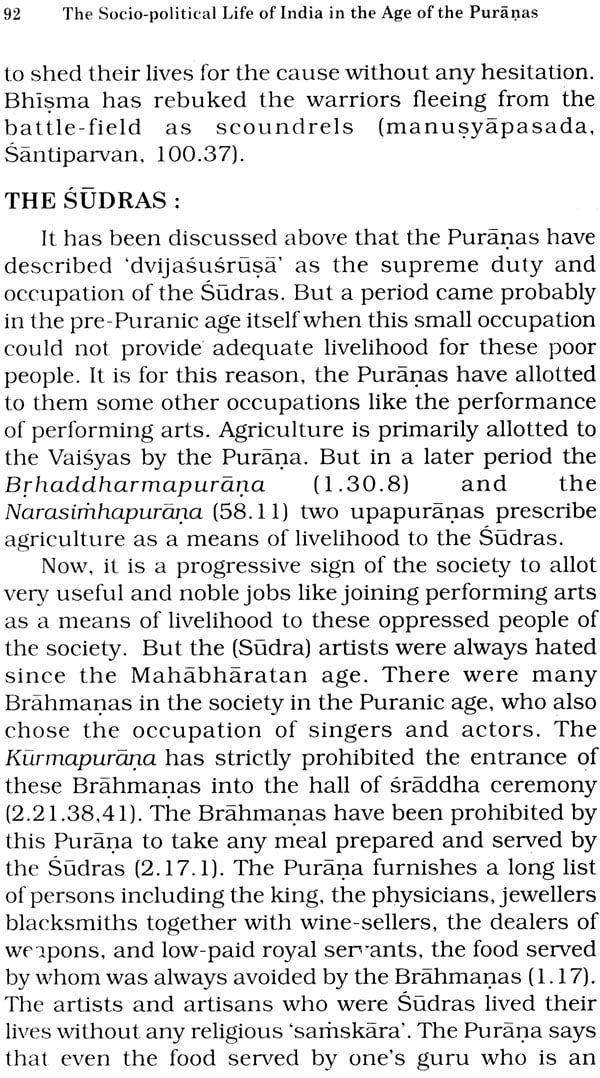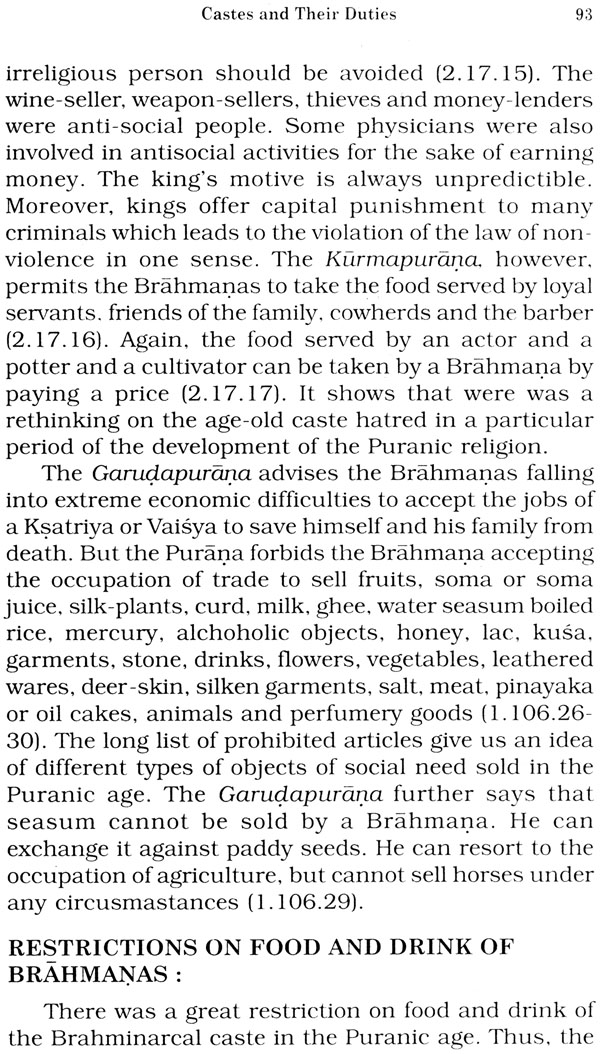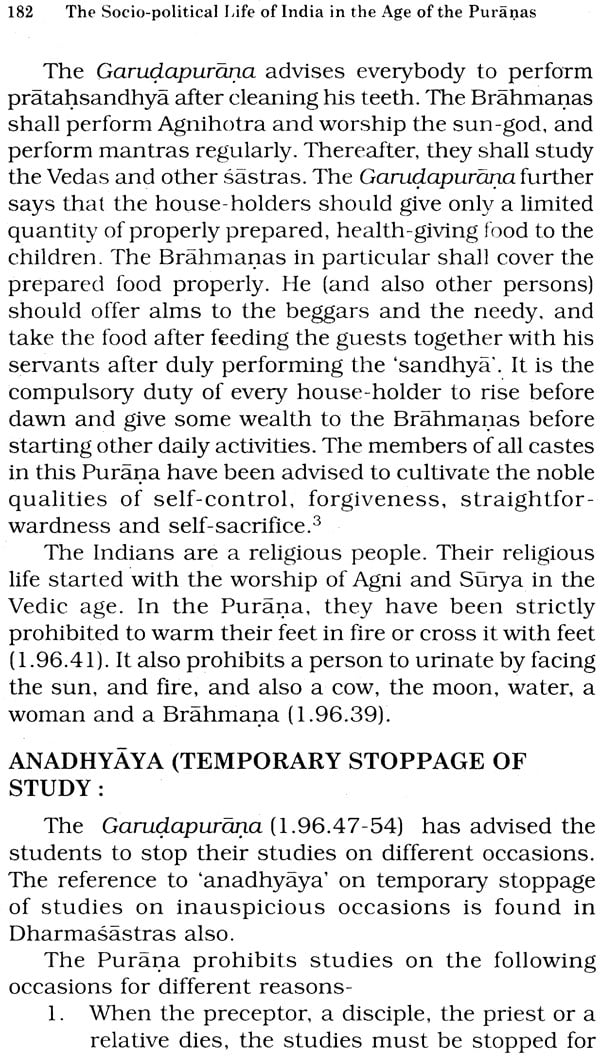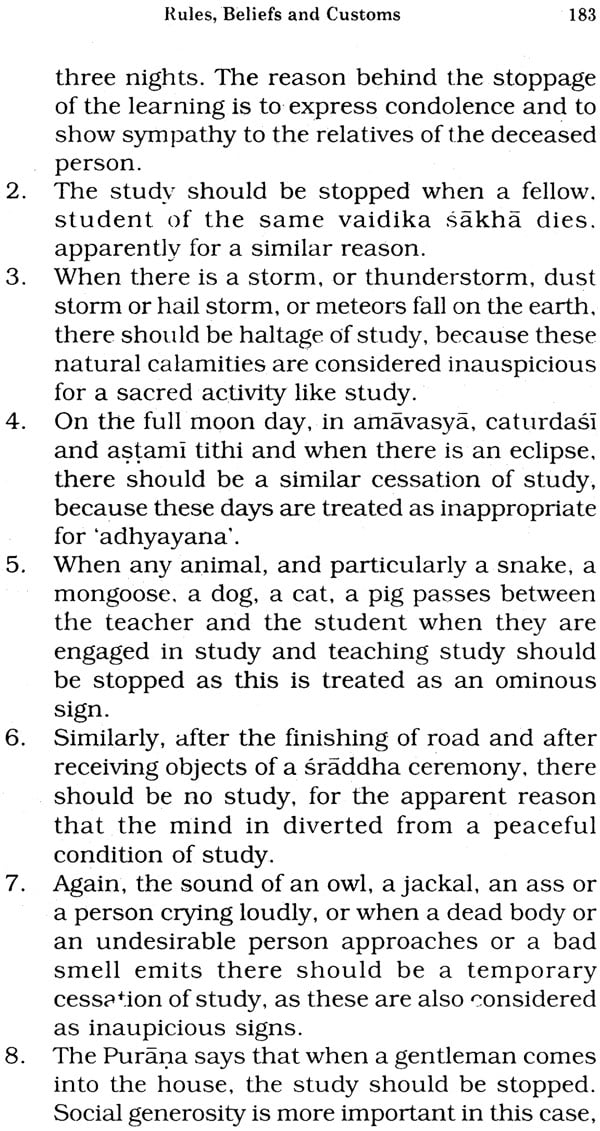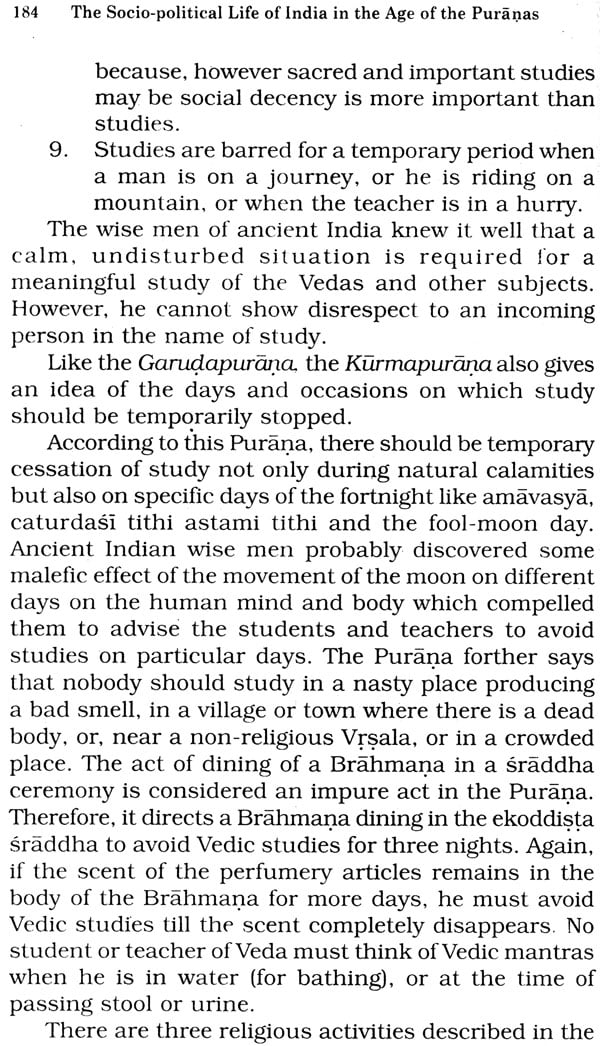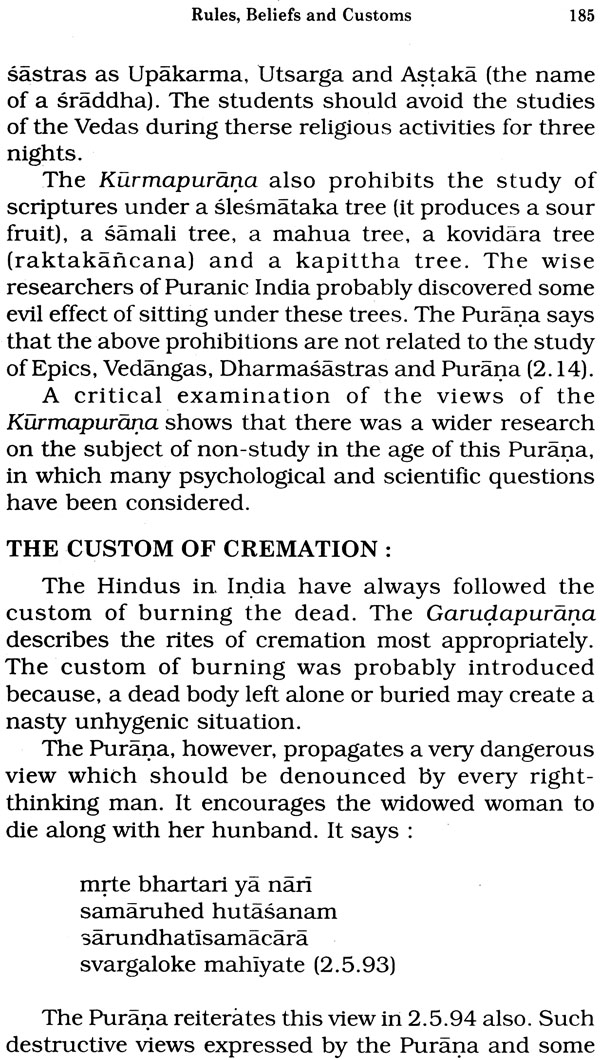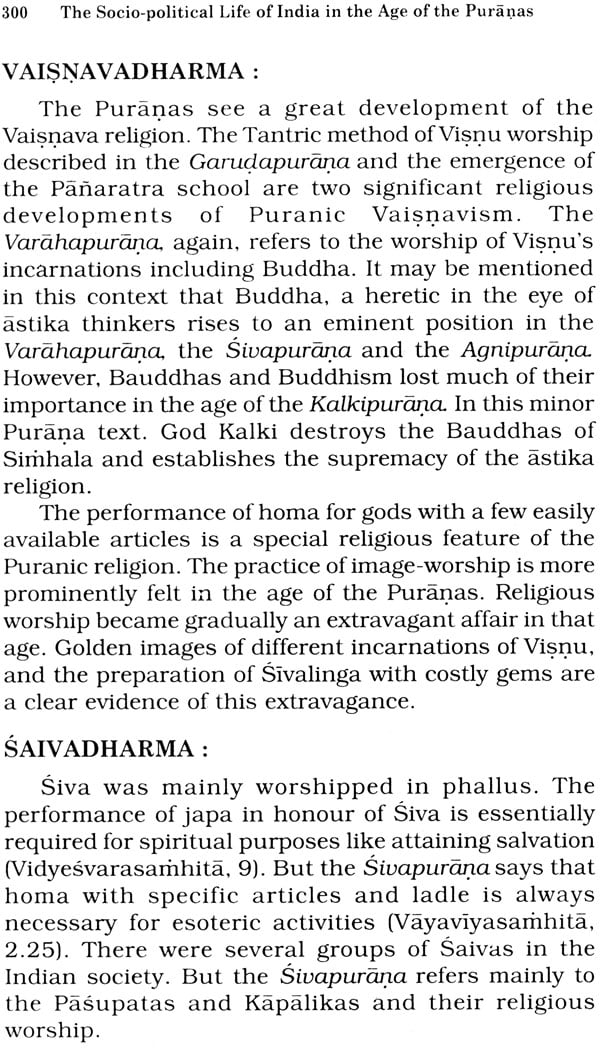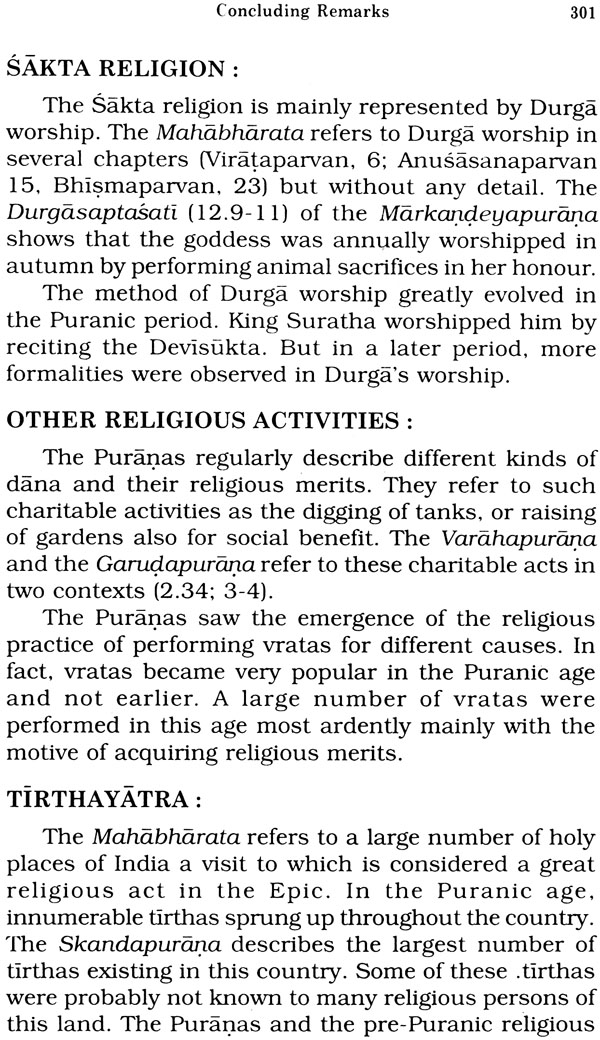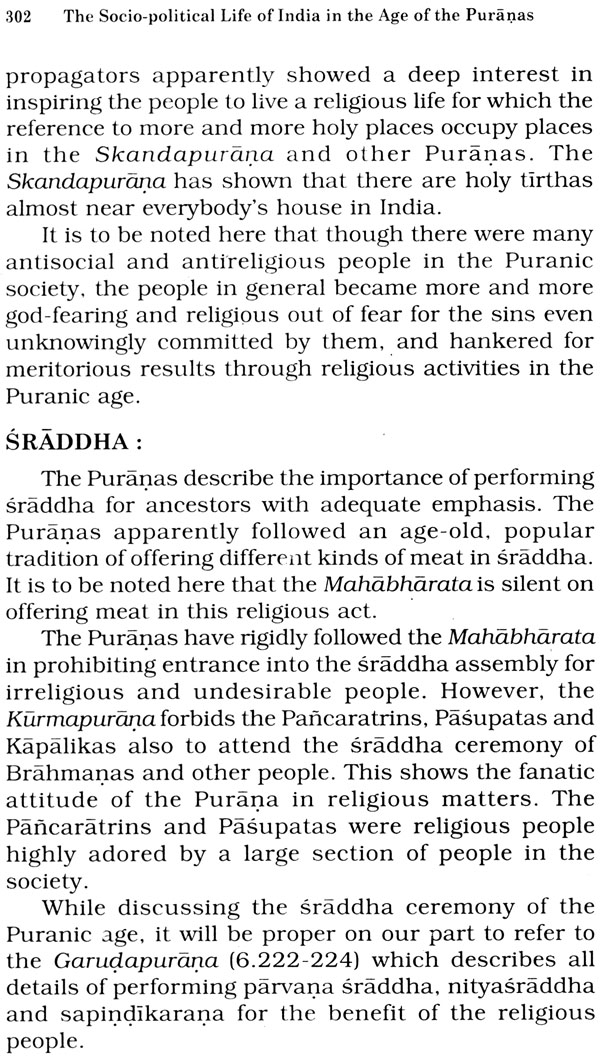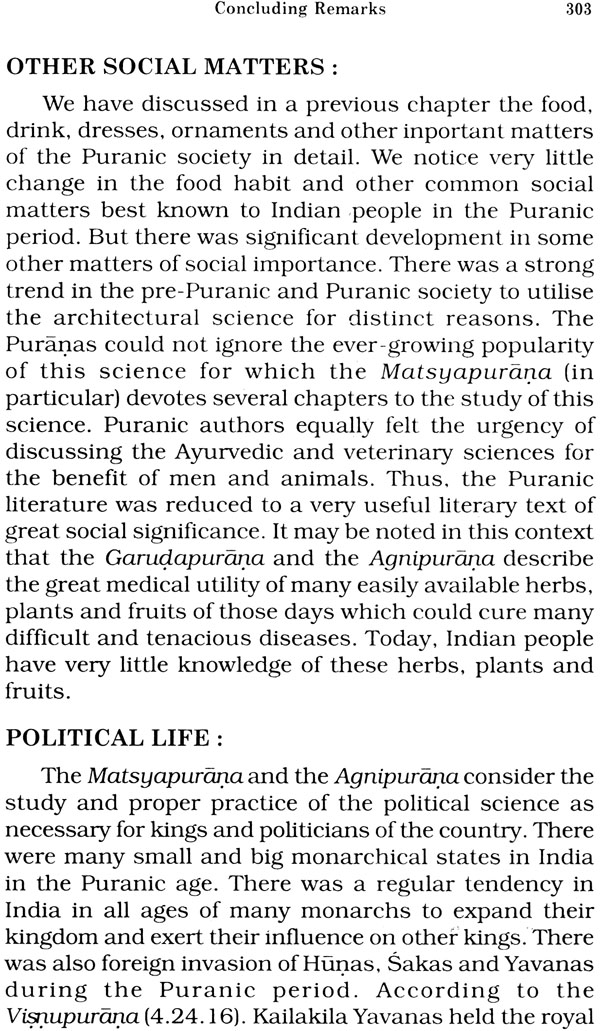
The Socio-Political Life of India in The Age of The Puranas
Book Specification
| Item Code: | NAG131 |
| Author: | Apurba Chandra Barthakuria |
| Publisher: | PUNTHI PUSTAK |
| Language: | English |
| Edition: | 2013 |
| ISBN: | 9789381209141 |
| Pages: | 320 |
| Cover: | Hardcover |
| Other Details | 8.5 inch X 5.5 inch |
| Weight | 520 gm |
Book Description
The present book viz. The Scio-political life of India in the age of the Puranas contains an introduction to the Puranas which is followed by nine chapters containing different aspects of the socio-political life of India. The book is completed with Concluding Remarks and a bibliography.
The contents of the book are given below :
Introduction: A general introduction to the Puranas and upapuranas. It refers to the upa-puranas like the Kapila and the Sambapurana.
Chapter-I: The economy of India in the Puranic age.
Chapter-II: The political system of India. It deals with the monarchical system of the age together with the measures of deference and administration.
Chapter-III: It contains a details discussion on castes and their duties.
Chapter-IV: The Asrama system and its significance in social life.
Chapter-V: This chapter is devoted to the study of food, drinks, dresses, ornaments and cosmetics of Puranic India, and other relevant social matters.
Chapter-VI: The chapter offers a detailed study of the academic life of India including the study of Ayurveda and the science of botany.
Chapter-VII: The rules, beliefs and customs of the Puranic age are adequately discussed in this chapter.
Chapter-VIII: Men and women of the Puranic period of India are elaborately studied in this chapter.
Chapter-IX: It is an extensive chapter dealing with the multi-coloured religious life of India of the age.
The chapter is followed by Concluding Remarks on the subject of present study.
Dr. Apurba Chandra Barthakuria, the author of the present book is an eminent Sanskrit Scholar of India. He has a vast knowledge of English, Bengali and Assamese literature also. He stood first class first in B.A (Hons) and MA in Sanskrit in Gauhati University. Calcutta University conferred the Ph.D (Arts) degree on Barthakuria in 1975 for his thesis. “A critical study of ‘Karaka”. Dr. Barthakuria has published 13 books on Indology and 81 research papers and articles on Sanskrit in different languages. He was a Professor in Sanskrit, Gauhati University for 39 years.
President of India has conferred the ‘Certificate of Honour’ to Barthakuria for his contribution to Sanskrit study and the propagation of Sanskrit in 2004. He has been appointed a professor in K.K Handique Govt. Sanskrit College, Assam as a Sastracudamani scholar by Rashtriya Sanskrit Sansthan, (Deemed University) Delhi recently. Dr. Barthakuria is the President of Asom Sanskrit Mahasabha, the representative organisation of the propagation of Sanskrit in Assam.
The Puranas are a class of Sanskrit religious literature which have enjoyed an immense popularity in the socio-religious life of India. They have greatly dominated the religious and spiritual field of the India people like the Mahabharata and the smrtisastras of this country.
The Puranas are, however, not liturgical texts discussing the technical aspects of worship of different gods and goddesses, though a few Puranas like the Garudapurana have dealt with this very important subject occasionally in the interest of the religious worshippers. These religious works have been dedicated to the propagation of the greatness of the gods like Visnu, Siva, Durga and Ganesa, through the poetic narration of their extraordinary exploits and divine powers, in their worship and their meritorious result, in order to attract the people to live a pure, religious life in their honour.
Many of the Puranas, however, render many other useful services to the academic world, apart from preaching religious ideas. The Purana has been generally defined as ‘puranam pancalaksanam’ which means that this particular class of literature possesses five chief features like sarga (creation) pratisarga (recreation) vamsa (genealogy of gods and seers), Manvantara the period dominated by particular Manus and Vamsanucarita (the dynasties of kings). But though the Puranas have maintained this formality apart from singing the glory of deities, many of them have crossed the boundary and discussed a large number of subjects of great academic importance like politics, the martial science, and the new architectural science of building excellent palaces.
The Puranas incidentally give an extensive knowledge of the vast geographical territory of India with all its specific features together with its innumerable holy rivers and mountains which remain scattered all over this country. In fact, the geographical study of Indian in the Puranas is itself a very important subject of research. The eminent writers like Dr. Savitri Sexena have utilised the subject fully in their project.
Apart from the above specific features, the Puranasa also give the readers an appropriate knowledge of the foods, drinks, dresses and ornaments and the social behaviour of the people, their rules and customs, their religious and spiritual life and thoughts and beliefs in the course of discussion on religious and other matters. Thought the Puranic authors were mainly religious teachers, many of them have devoted their energies to study of the political science. Again, the Puranas, while dealing with their own subject of study have incidentally referred to the forest life of India which was dominated by a luxuriant growth of many precious trees and a vast population of Indian birds and beasts and at the same time the forest was an ideal dwelling of many ascetics.
After a close examination of the above features of the Puranas, the present author has arrived at the opinion that a work written on the socio-political aspect of the Puranic life of India will be of great use to the scholars.
I am grateful to Dr. Shila Purakayastha, Dr. Manjula Devi, Professor of Sanskrit, Gauhati University Dr. Banikanta Sharma, President of Assam Research Society and Professor Umakanta Sharma, four great researchers of Indology for the constant inspiration given by them to me publisher this book.
I shall remain grateful to P.K. Bhattacharya of Punthi Pustak, Kolkata for kindly consenting to publish the book from his farm.
I shall be happy if the present book on Puranas render some to the scholars.
The Puranas are a class of religious literature written mainly in the post-Mahabharata period. Though the Mahabharata suggestively refers to the existence of Puranas (Vanaparvan,) in its age, the Puranas known to the readers with their specific titles were written after the Great Epic assumed its final shape. They were composed in different periods of history the entire period covering more than one thousand years.
Thus, the Puranas are an important source-book for the study of India’s cultural life, political system, and its geography and history extending over a vast period of its civilization.
THE MENING OF THE WORD PURANA :
The word Purana literately means an old narrative. But the Indian tradition defines Puranas as, ‘puranam pancalaksanam’. According to it, the Puranas shall have five (chief) characteristics viz. i) Sarga or creation ii) Pratisarga or recreation, that is, periodical dissolution of the universe, and then its reappearance, iii) Vamsa or the genealogy of gods and rsis iv) manvantara or the periods governed by Manus, and v) Vamsanucarita or the history of generation (of kings).
However, these characteristics play only a formal role in many Puranas, where many other matters like politics, medical and veterinary science and kavya and some other matters have been more prominently discussed. In this context we can refer to the Matsyapurana, the Garudapurana and the Agnipurana which deal with many very important aspects of Indian culture.
The number of Puranas :
‘Puranas refer to eighteen major Puranas viz.-
1 Brahma
2 Padma
3 Vaisnava or Visnupurana
4 Saiva (Sivapurana)
5 Bhagavata
6 Naradiya
7 Markandeya
8 Agneya (or Agni)
9 Bhavisya
10 Brahmavaivarta
11 Lainga (Lingapurana)
12 Varaha (Varahapurana)
13 Skanda (Or Skandapurana)
14 Vamana
15 Kaurma (Kurmapurana)
16 Matsya (Matsysapurana)
17 Garuda(Garudapurana)
18 Brahmanda
Now, a critical examination of the above list is given in a number of Puranas including the Visnupurana (part 3, 6), the Bhagavatapurana (XII, 13), the Matsyapurana (53, 12-55), and the Varahapurana (112.69-72).
It is interesting that the above and some other Puranas mention all the Puranas including their own names in the list. It shows that the relevant passage regarding the account of 18 Puranas is either a later interpalation or there were some ur-Puranas which have been mentioned in the later Puranas of the same name.
M. Winternitz shows that the list of 18 Puranas was read to AI-Beruni (about 1030 A.D.) from the Visunpurana. AI-Beruni was conversant with the Adityapurana, the Vayuprana and the Visnudharmottarapurana. But interestingly the names of the Vayuprana and the Adityapurana do not appear in the list mentioned above.
The Vayupurana give the knowledge of the Gupta rulers of this country. The Purana occupied a place in the available to AI-Beruni. Winteritz also recognises its importance in the study of Indian history. Bit the Puranic tradition mentioned above is conspicuously silent about this Purana. The reason for this is best known to the Puranic authors themselves. Of course, the Kurmapurana (1.1.15) refers to a Vayaviyapurana. But in that case the numbers of Puranas become 19.
The Bhavisyapurana as it is available to modern readers was written in the 17th century A.D. or sometime later. The Purana refers to the great Sanskrit grammarian Bhattoji Diksita who flourished in 1606 A.D. according in the Belvalkar. If the Purana by this name as described in the Visnupurana (3.6.22) was read to AI-Beruni who flourished in about 1030 A.D., the context of this Puranic text was certainly different to a great extent form the modern edition of the text.
UPAPURANAS :
Apart from the major Purana the tradition refers to several minor Puranas (Upapuranas) also. Thus, the Kurmapurana (1.1.17-20) refers to 18 minor Puranas viz.
1 Adipurana
2 Narasimha
3 Skandapurana
4 Sivadharma
5 Ascaryapurana
6 Naradiyapurana
7 Kapilaurana
8 Vamanapurana
9 Usanahpurana
10 Brahmanda
11 Varunapurana
12 Kailkapurana
13 Sambapurana
14 Parasarapurana
15 Saurapurana
16 Parasarapurana
17 Maricapurana
18 Bhagavatapurana
The Matsyapurana (35.59.62) describes four Upapuranas viz.-I) Narasimha 2) Nandipurana 3) Sambapurana and 4) Adityapurana.
The Matsyapurana was probably written before the kurmapurana, as many new Puranas were know to the society in the age of the Kurmapurana which were written by religious poets considering the social necessity.
PURANIC VIEWS ON THE COMPOSITION OF MAJOR AND MINOR PURANAS
Several Puranas refer to the origin of many major and minor Puranas which deserve an examination in a modern Puranic research.
i) The Matsyapurana says that a Purana containing 100 crores of verses was written first. But Vedavyasa abridged this Purana into 4 lakhs of slokas. This Puranic text was divided into 18 major Puranas, and the verses were also divided among them.
Regarding the minor Puranas, the Matsyapurana says that the Narasimha upapurana is based on the Narasimha legend of the Padmapurana. The Nandipurana was composed is by Kartikeya on the greatness of Nandi. The Samba upapurana has been composed on the sun-worship of Samba. The Aditya upapurana was the fourth minor Purana (written on the greatness of sun-god) [53.59.62].
ii) Regarding the origin of the Visunpurana, the Purana says that there was one original text of the Purana. But three students of sage Lomaharsana wrote a new Purana each on the basis of the original text. Suta wrote his Sutasamhita. The Visnupurana is based on the contents of four works (Visnupurana, 3.6.11-20).
iii) The Kurmapurana give the readers an idea of the origin of the minor Puranas (1.17-20). According to this Purana, Sanatkumara wrote the Adipurana. Kartikeya wrote the Skandapurana Nandisvara wrote the Sivadharma, the Ascaryapurana is a composition of Durvasa while Usana wrote the Bhargava (upa) purana.
It appears form the above discussion of the Puranas that there was a living tradition regarding the origin of important Puranas and upapuranas.
| Preface | v | |
| Introduction | 1 | |
| Chapter-I | The Economy of the Country | 19 |
| Chapter-II | Political System | 43 |
| Chapter-III | Castes and their duties | 84 |
| Chapter-IV | The Asrama Sysetm | 105 |
| Chapter-V | Food, Drink, Dresses, | |
| Ornaments and Cosmetics | 117 | |
| Chapter-VI | Academic Life | 143 |
| Chapter-VII | Rules Customs and Beliefs | 179 |
| Chapter-VIII | Men and Women | 196 |
| Chapter-IX | The Religious Liife of India | 212 |
| Concluding Remarks | 297 | |
| Bibligraphy | 306 | |
| Index | 309 |
